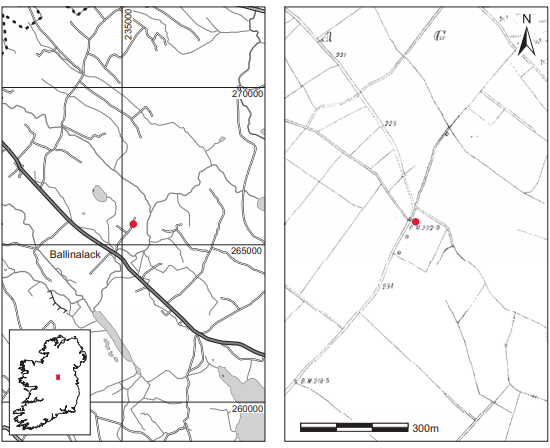County: Westmeath Site name: CAPPAGH, CO. WESTMEATH
Sites and Monuments Record No.: SMR WM006-071 Licence number: E1164
Author: MARY CAHILL
Site type: Late medieval graves, c. AD 12001600, and post-medieval graves, AD 16001800
Period/Dating: —
ITM: E 635306m, N 765679m
Latitude, Longitude (decimal degrees): 53.639718, -7.466097
Introduction
In May 1988 an inhumation burial was discovered during the removal of a field fence on a farm near Ballinalack, Co. Westmeath. Brendan Cox, the landowner, reported the site to the Gardaí, who informed the NMI. A one-day investigation was carried out by Mary Cahill. This report is based on Mary Cahill’s report of the find and on Barra Ó Donnabháin’s report on the human remains.
Location (Fig. 5.16)
The site was in the townland of Cappagh in north-west County Westmeath, close to the border with County Longford.30 It was 1km north-east of Ballinalack village, 1km south-east of Lough Garr and 4km west of Lough Derravaragh. The surrounding area is low-lying— approximately 70m above sea level—and contains frequent tree plantations. The site is some 400m west of the border between the baronies of Moygoish and Corkaree.
Description of site
Unfortunately, the area in which the skeleton had been discovered had been disturbed at the time of inspection but, according to the landowner, the skeleton was uncovered beneath the field fence. Mr Cox described a covering of limestone pebbles over the area where the body lay. It is not possible to say whether this formed part of the grave or was associated with the field fence. No further details could be recorded as to the form of the grave, but the absence

Fig. 5.16—Location map, Cappagh, Co. Westmeath.
of slabs would seem to suggest that this might have been an unlined grave, possibly with a covering of stone pebbles.
Owing to the level of disturbance, it was not possible to ascertain the disposition of the skeleton (1988:15). No accompanying artefacts were found. The human remains were found by Ó Donnabháin to represent the remains of an adult, probably male.
Comment
Owing to the interesting location of the burials close to significant boundaries, a sample of the bone was submitted for radiocarbon dating. Two samples were dated, giving dates of 275±40 BP and 245±40 BP, which calibrate to 1483–1953 and 1517–1955 respectively.31
HUMAN REMAINS
BARRA Ó DONNABHÁIN
The remains (1988:15) are those of one individual and consist of fragmentary portions of a skull, both femora and tibiae, the right humerus, radius and ulna, as well as fragments of the second cervical and second or third sacral vertebrae. Despite their fragmentary state, most of the bones are reasonably well preserved. Exceptions to this are the femora and right tibia. The cortical bone has been exfoliated from these latter elements. None of the long bones is complete and the only articular surface present is a portion of the head of a femur.
The general size of the bones and the morphology of the mastoid processes of the skull suggest that this was a male. Only the mandibular dentition was recovered. All of the mandibular teeth are present; as the third molars had erupted and were in occlusion, this individual was at least eighteen years old. The degree of tooth wear observed is very slight and may indicate that this was a younger adult. The fragment of femur head suggests that this epiphysis was in the process of fusing to the diaphysis, so an age at death of 18–20 years seems most likely.
The only pathological condition encountered is cribra orbitalia, which occurs in both orbits. This condition is generally thought to be the result of iron-deficiency anaemia, which is often caused by intestinal parasite infestation or nutritional deficiency or a combination of both. Two pieces of non-human bone were also recovered. One is a complete metapodial while the other is a fragment of a long bone shaft.
30. Parish of Russagh, barony of Moygoish. SMR WM006-071——. IGR 235363 265660.
31. GrA 24314 and GrA 24470 respectively.